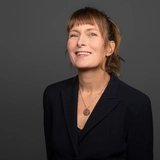
Katharina Grosse, Anne Imhof, Rosemarie Trockel, Ólafur Elíasson and Jonathan Monk, these are just a few of the more than 100 Berlin artists that STUDIO BERLIN presents at the Techno-Club Berghain. The exhibition itself is intended as a snapshot, as a reflection on the current situation in which art and culture are not as originally planned, in which nightlife should and cannot take place at all.
At the same time, this cooperation between the Techno-Club Berghain and the patron of the arts Christian Boros shows how new ways can be successfully found. You get great insights into the Berlin art scene. We cannot show you the complete works of the artists exhibited at Berghain. But we hope to make you curious enough to take a closer look at one or the other concept and to learn more about the intention and origin of the artists.
Tip 1: Jessica Ekomane
Jessica Ekomane experiments with space and sound, consciously aiming to understand how these two elements influence our physical experience. In her piece "Comedown" in the Panorama Bar, the sound artist uses elements and fragments from club music, which trigger both euphoria and frustration in the listener. Not necessarily danceable, but listen in and find out what this soundscape feels like for you.
Tipp 2: Khaled Barakeh
In some languages you read from right to left, in Arabic or Hebrew for example. And so time also ticks the other way round in Khaled Barakeh's contribution to the group exhibition in Berghain. With his works, the Syrian-born conceptual artist and activist draws attention to dissonances and injustices in existing political and social structures. In doing so, he refers to individual snapshots, which he would like to make tangible and understandable for a wider audience with his works.
Tip 3: He Xiangyu
When He Xiangyu starts experimenting with materials, they usually turn into something completely different. Thus, the Berlin artist, who grew up in China, repeatedly confronts our perception with the challenge of dealing with change, with the transformation of objects. Nothing is as it is - or at least different from what we think it is. At STUDIO BERLIN he is showing his sculpture "Asian Boy".
Tip 4: Oliver Laric
It is the beings between two worlds that fascinate Oliver Laric. One of them is the Pan from Greek mythology. Half man, half goat, the forest god Pan with his flute is a symbol of unsophisticated cheerfulness. Using 3D scanning, Laric has the creatures he has found re-materialised in other places. The original Pan is made of a piece of antique marble taken from an old well. The pan you see in the Berghain is made of polyamide and polyurethane.
Tip 5: Shirin Sabahi
In her video works, the artist, who was born in Tehran, deals with architectural environments. What do they mean according to the epoch and period in which they were created? And how do they appear in the present? What role do they play as space for the people who use them? With "Lung" the artist documents how air is released from an air dome (see picture) above a Berlin swimming pool. Well, do you know where that was in Berlin?
Tip 6: Christine Sun Kim
Sounds are vibrations that cause the eardrum to vibrate. This is how we hear. But sound and sound can also be felt elsewhere, making floors vibrate and hitting us in the middle of our stomach. Christine Sum Kim is deaf, and that is exactly why the Korean-born artist has made sound an important element of her works. Studio.Berlin shows Shoegazing, an installation that you can find - matching the title - where your shoes touch the floor.
Tip 7: Nasan Tur
Nature is cruel, because the strongest always wins.This is different with the sculpture Nasan Tur is exhibiting at Studio.Berlin. It is part of his series AGONY; in which he reverses the law of the strongest. Victims become winners. What do you think about this idea?
Tip 8: Raphaela Vogel
Come in, come in: With her installations and video projections Raphaela Vogel creates obscure environments in which you can rediscover the world. Art theatre so to speak, dream cinema, medusa-like magnetic. Check it out! At Studio.Berlin you can watch the video "9 architecture models".
Tip 9: Thea Djordjadze
The installations of this Georgian-born artist are difficult to describe, probably best described with the words "intangible". Djordjadze reassembles old and self-formed objects in a new way, setting art historical as well as contemporary references. But if you look closely, you will recognise one thing above all else, namely how poetic change can be in itself.
Tip 10: Alvaro Urbano und Petrit Halilaj
Both artists deal with structures, with architecture and space. Petrit Halilaj, who comes from Kosovo, also repeatedly deals with the history of his homeland in his work. It is about destruction and reconstruction. Urbano originally studied architecture. He too is inspired by the theme of impermanence and in his work visualises possible visions of the future for buildings affected by decay.
Tip 11: Leila Hekmat
Leila Hekmat is known for her costumes, which she designs for experimental theatre performances. The plays, some of which she writes and directs herself, are usually shown to small audiences. Costume design is part of her exhibition. Studio.Berlin shows her Magazine Shop.






